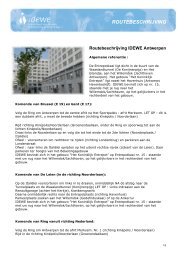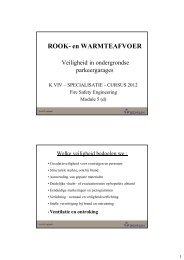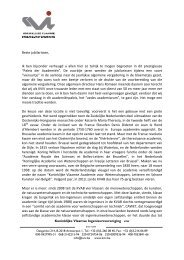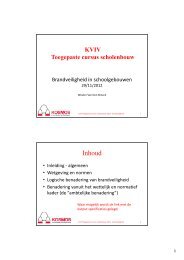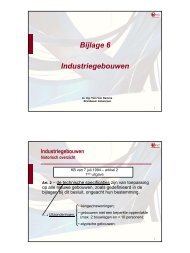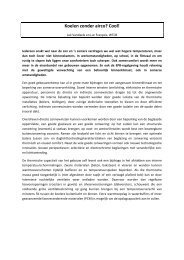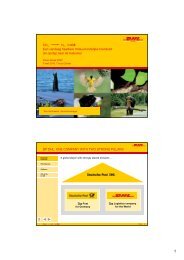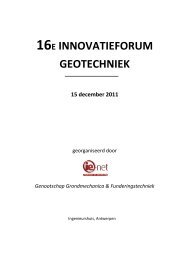Schoonbaert volledig - ie-net
Schoonbaert volledig - ie-net
Schoonbaert volledig - ie-net
Create successful ePaper yourself
Turn your PDF publications into a flip-book with our unique Google optimized e-Paper software.
An Updated International Survey ofComputer Models 109<br />
101. Heskestad, A. W., Jensen, G., Meland, O. and Torlen, E., ‘‘ALLSAFE: An Engineering<br />
Tool for Evacuation Safety Design,’’ In: Proceedings ofthe Fire Safety by Design<br />
Conference, Vol. 3, CIB W14, UK, 1995.<br />
102. Paulsen, T., Soma, H., Schneider, V., Wiklund, J. and Lovas, G., Evaluation of<br />
Simulation Models of Evacuation From Complex Spaces (ESECX), SINTEF Report<br />
STF75 A95020, 1995.<br />
103. Kendik, E., ‘‘Determination of the Evacuation Time Pertinent to the Protected Area<br />
Factor in the Event of Total Evacuation of High-Rise Office Buildings via Staircases,’’<br />
Fire Safety Journal, Vol. 5, 1982, p. 223.<br />
104. Ketchell, N., Cole, S., Webber, D. M., Marriott, C. A., Stephens, P. J., Brearley, I. R.,<br />
Fraser, J., Doheny, J. and Smart, J., ‘‘The EGRESS Code for Human Movement and<br />
Behaviour in Emergency Evacuations,’’ Engineering for Crowd Safety, Institution of Civil<br />
Engineers, London, 1993.<br />
105. Klote, J. H. and Alvord, D. M., Routine for Analysis of the People Movement Time for<br />
Elevator Evacuation, NISTIR 4730, National Institute of Standards and Technology,<br />
1992.<br />
106. EVACNET4 User’s Guide, http://www.ise.ufl.edu/kisko/files/evac<strong>net</strong>/EVAC4UG.HTM<br />
107. Takahashi, K., Tanaka, T. and Kose, S., ‘‘An Evacuation Model for the Use in Fire Safety<br />
Designing of Buildings,’’ In: Proceedings ofthe 2nd International Symposium on Fire Safety<br />
Sc<strong>ie</strong>nce; International Association for Fire Safety Sc<strong>ie</strong>nce, 1988.<br />
108. Fahy, R. F., ‘‘EXIT89 – An Evacuation Model for High-Rise Buildings – Model<br />
Description and Example Applications,’’ In: Proceedings ofthe Fourth International<br />
Symposium, International Association for Fire Safety Sc<strong>ie</strong>nce, 1994, pp. 657–668.<br />
109. Personal communication with Michel Curtat, Centre Sc<strong>ie</strong>ntifique et Technique du<br />
Batiment, France, curtat@cstb.fr.<br />
110. Thompson, P. A. and Marchant, E. W., ‘‘A Computer Model for the Evacuation of Large<br />
Building Populations,’’ Fire Safety Journal, Vol. 24, 1995, pp. 131–148.<br />
111. Shestopal, V. O. and Grubits, S. J., ‘‘Evacuation Model for Merging Traffic Flows in<br />
Multi-room and Multi-storey Buildings,’’ In: Proceedings ofthe 4th International<br />
Symposium on Fire Safety Sc<strong>ie</strong>nce, IAFSS, 1994, pp. 625–632.<br />
112. Quint<strong>ie</strong>re, J. and McCaffrey, B., The Burning of Wood and Plastic Cribs in an Enclosure:<br />
VolumeI, NBSIR 80-2054, National Bureau of Standards (now National Instituteof<br />
Standards and Technology), 1980.<br />
113. Hagglund, B., A Room Fire Simulation Model, Department of Defense, FAO Report<br />
620501-D6, Stockholm, Sweden, 1983.<br />
114. Wickstrom, U. and Goransson, U., ‘‘Flame Spread Predictions in Room/Corner<br />
Test Based on the Cone Calorimeter,’’ In: Proceedings of the Interflam Conference, 1990.<br />
115. Pape, R., Waterman, T., and Eichler, T.V., ‘‘Development of a Fire in a Room from<br />
Ignition to Full Room Involvement – RFIRES,’’ NBS-GCR 81-301, National Bureau of<br />
Standards (now National Instituteof Standards and Technology), 1981.<br />
116. D<strong>ie</strong>tenberger, M., Technical Reference and User’s Guide for FAST/FFM Version 3,<br />
NIST-GCR-91-589, National Instituteof Standards and Technology, 1991.<br />
117. Zukoski, E. and Kubota, T., ‘‘Two-Layer Modeling of Smoke Movement in Building<br />
Fires,’’ Fire and Materials, Vol. 4, 1980.<br />
118. Janssens, M. L., An Introduction to Mathematical Fire Modeling, 2nd Edn., Technomic<br />
Publishing Company, Inc., 2000.<br />
119. Joshi, A. A. and Pagni, P. J., Users’ Guide to BREAK1, The Berkeley Algorithm for<br />
Breaking Window Glass in a Compartment Fire, NIST-GCR-91-596, National Institute<br />
of Standards and Technology, 1991.<br />
120. Mowrer, F. W., Methods of Quantitative Fire Hazard Analysis, Electric Power Research<br />
Institute, EPRI TR-100443s, 1992.




